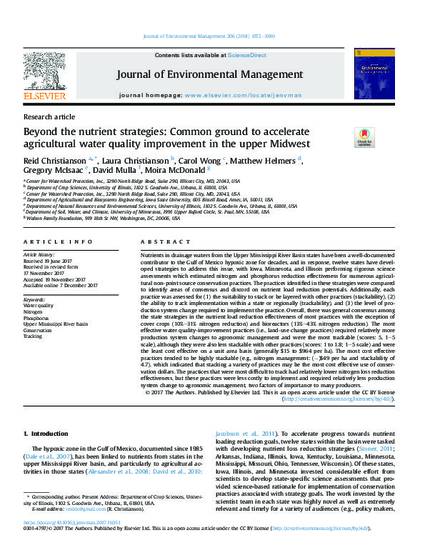
Nutrients in drainage waters from the Upper Mississippi River Basin states have been a well-documented contributor to the Gulf of Mexico hypoxic zone for decades, and in response, twelve states have developed strategies to address this issue, with Iowa, Minnesota, and Illinois performing rigorous science assessments which estimated nitrogen and phosphorus reduction effectiveness for numerous agricultural non-point source conservation practices. The practices identified in these strategies were compared to identify areas of consensus and discord on nutrient load reduction potentials. Additionally, each practice was assessed for (1) the suitability to stack or be layered with other practices (stackability), (2) the ability to track implementation within a state or regionally (trackability), and (3) the level of production system change required to implement the practice. Overall, there was general consensus among the state strategies in the nutrient load reduction effectiveness of most practices with the exception of cover crops (10%–31% nitrogen reduction) and bioreactors (13%–43% nitrogen reduction). The most effective water quality-improvement practices (i.e., land-use change practices) required relatively more production system changes to agronomic management and were the most trackable (scores: 5, 1–5 scale), although they were also less stackable with other practices (scores: 1 to 1.8; 1–5 scale) and were the least cost effective on a unit area basis (generally $15 to $964 per ha). The most cost effective practices tended to be highly stackable (e.g., nitrogen management: (−)$49 per ha and stackability of 4.7), which indicated that stacking a variety of practices may be the most cost effective use of conservation dollars. The practices that were most difficult to track had relatively lower nitrogen loss reduction effectiveness, but these practices were less costly to implement and required relatively less production system change to agronomic management, two factors of importance to many producers.
Available at: http://works.bepress.com/matthew_helmers/187/

This article is published as Christianson, Reid, Laura Christianson, Carol Wong, Matthew Helmers, Gregory McIsaac, David Mulla, and Moira McDonald. "Beyond the nutrient strategies: Common ground to accelerate agricultural water quality improvement in the upper Midwest." Journal of Environmental Management 206 (2018): 1072-1080. DOI: 10.1016/j.jenvman.2017.11.051. Posted with permission.